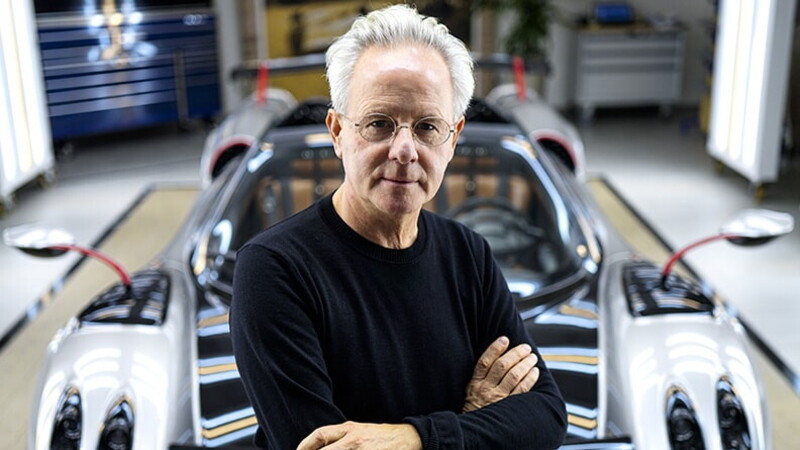Pagani, the super-fast story of a dream, which happens in Imola

Horacio Pagani is a Renaissance maestro who has lived, however, astride the 20th and 21st Centuries. Born in Casilda – in the province of Santa Fe – in 1955, and leaving Argentina with a letter of recommendation signed by Juan Manuel Fangio, Pagani arrived in Italy in 1983 and has dedicated his life to a personal dream – creating a car firm in his own name.
His first job in the 1980s was as a worker at Lamborghini, where he took part in futuristic projects such as the 1987 Countach Evoluzione, moving on to found his own workshop/boutique in San Cesario sul Panaro, where he has produced jewels such as the Zonda, the Huayra and the Pagani Imola.
You have been in Italy for almost forty years: what has changed?
“Let us say that as regards my passion, my curiosity, my interest in life and in my work, I believe that I am the same person. Certainly, when you are twenty years old, perhaps you are more courageous, you are less fearful. In those days, of course, I was alone, there was just my wife, and I wasn't responsible for 170 people working alongside me, with all the advantages and disadvantages which that entails. Having employees – and you think about them a lot in times like these - means so many families, so many suppliers who work for the company. The sense of responsibility becomes greater”.
Staying in the past, but in a more recent past: in 2011 Pagani, after having impressed the world with your first hypercar, the Zonda, you introduced the Huayra at the Pirelli headquarters, in Milan. What do you remember about that period?
“The Huayra, compared with the Zonda, was a much more complex project, as it was designed to be regulation-compliant across the whole planet, and therefore in conformity with American standards, with fifty crash tests, emission values to be respected, and so on; actually, it represented a major effort. When in 2011 we made the Huayra, things were becoming serious for Pagani, we were starting to become a serious player”.
And then you created a car with the name of the racetrack at Imola; what is the link with that circuit?
“The first time that I went to that Santerno racetrack was in 1983, with my wife. We had just arrived in Italy and we immediately went to see the Formula 1 Grand Prix. After that, we didn't miss a single one; we always went there; even in 1987, when our first child was born, we went with the buggy”.
During the 1980s you were still working for Lamborghini…
“I remember that we went to Imola to test the Countach Evoluzione with two major Formula 1 drivers, Jabouille and Laffite: it was an incredible experience, to be there with that car and those drivers”.

These days do you use a racetrack or a test bed to assess a Pagani's performance?
“When we build a new model, we have one validation cycle for the road and one for the racetrack, and Imola is our main racetrack. We perform around 16 thousand km of tests – around three times the Le Mans 24 Hours – on a racetrack, for one part of which we do indeed use Imola, because Imola provides a fierce examination of everything: transmission, aerodynamics, brakes, and it is an extremely difficult circuit for a car like ours. Over time, as well, we have built up a really good relationship with the organisation, with everybody there: we know the doctors, the guys who clean the track, those who do the timekeeping, everyone. We have a really nice relationship, which is why we shared with them the idea of calling the car presented this year the “Imola”. Five units – all already sold – to serve as a tribute to this extraordinary racetrack”.
Once upon a time you said that Imola is a sacred place for every race car fan, why?
“Imola has gifted us extraordinary victories and terrible tragedies, which we shall never forget. Imola is like life: there is daytime and there is night time, there is light and there is also darkness. That is why it is a sacred place”.
How do you see the hypercar of the future – electric, hybrid or neither of these two things?
“Today customers, at least Pagani customers, still want a car which is not a hybrid, and nobody has ever asked us for an electric Pagani. We did a survey asking our customers what they might prefer. A hybrid with 1,000 HP and which weighs 1,750 kg, or a combustion-engined car, a twin-turbo which weighs 1,300kg with 850 HP? Not one of them told us that anything from the hybrid was important for them. But then perhaps in the future they'll change their opinion, and certainly our cars must always be in a position to provide thrills”.
Is that what you look for too when you get into a car?
“Over the years I've had the good fortune and privilege of driving a lot of cars, and I really like Porsches. I have a Carrera GT, a racer with 10 cylinders, and a 918, so beautiful in its design that I like to leave it below the window so that I can look at it. Nevertheless, if I'm looking for driving thrills, of the two I prefer the GT, which is less perfect, but gives me more pleasure. Other than that, our own cars, like Ferraris and Lamborghinis, must above all serve to gift us thrills.



